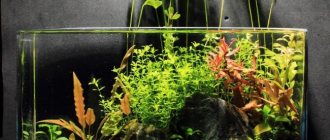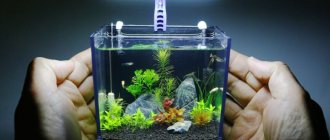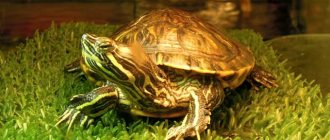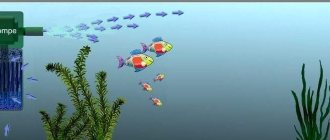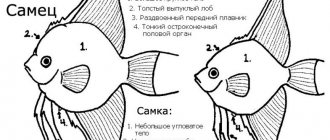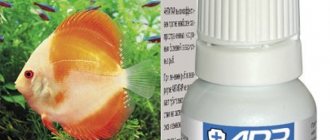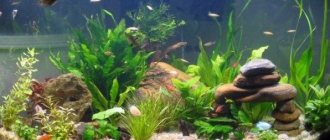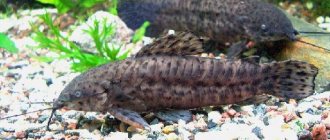Select the required aquarium size
Even if you are just starting your acquaintance with aquariums, you probably know that each type of fish has its own needs regarding space and their habitat. Some people will be comfortable in small aquariums (guppies, zebrafish, etc.). But a lot of free space is vital for a goldfish, otherwise it may die. Before purchasing an aquarium and its inhabitants, it is better to read in more detail about each species in advance.
A lack of free space leads to the following consequences:
- The fish refuse to eat and become very lethargic and inactive.
- Formation of rot on the fins.
- The color of the fish fades.
Changing the water in the aquarium
Despite the fact that some aquarists do not change the water for years and say that everything is fine, regular water changes are vital for the aquarium.
The amount of water that should be changed will vary depending on the conditions in your aquarium, but on average 10-20% per week is a normal amount for any tropical aquarium. Herbal tanks or tightly planted aquariums need 10-15% changes every two weeks.
The main task of the replacement is to remove nitrates and ammonia and restore the mineral balance. Without changing the water, your aquarium will look good for some time, but only due to the fact that negative factors gradually accumulate.
Over time, nitrates will accumulate and the water will become increasingly acidic. But one day the balance will be disrupted and the aquarium will turn into a swamp.
Proper diet
The basis of keeping aquarium fish is their nutrition. Food can be of several types:
- Natural. Live, frozen or gelled food.
- Dry. Available in the form of granules or flakes. It is selected in accordance with the anatomical structure of the mouth of the aquarium inhabitants.
- Supplements They are used as additional support, maintaining color and improving appearance.
The most important recommendation is to never overfeed your fish! After purchasing a new aquarium, you need to start by feeding it no more than once a day. Gradually, the frequency increases, but measures are needed here too. Don't forget that an aquarium is a closed habitat. If you give a lot of food, it will not be eaten, but will sink to the bottom. As a result, an ideal environment for the proliferation of harmful microorganisms is formed. In addition, from overeating, fish become fatter and reproduce worse.
The optimal feeding frequency for fry is 4 times a day, for guppies and goldfish - 2 times (features of feeding other species can be found on the Internet). Once a week you can have a fasting day.
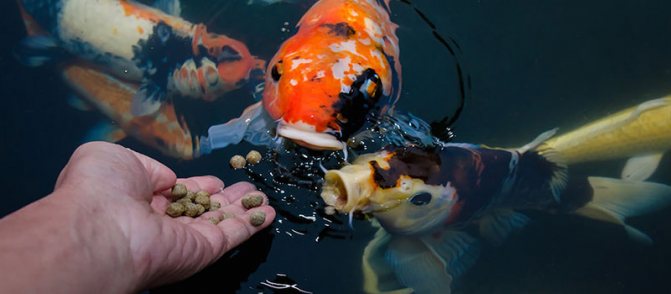
Stages of launching a water dwelling
First, the soil is laid and the equipment is installed, then the tank is filled with water (pour it onto your hand or a plate placed on the bottom so as not to wash away the soil), then the plants are planted. If the fish are herbivores, it is better to plant hard-leaved ones. If the inhabitants are indifferent to plants, any will do, taking into account the flora familiar to the fish.
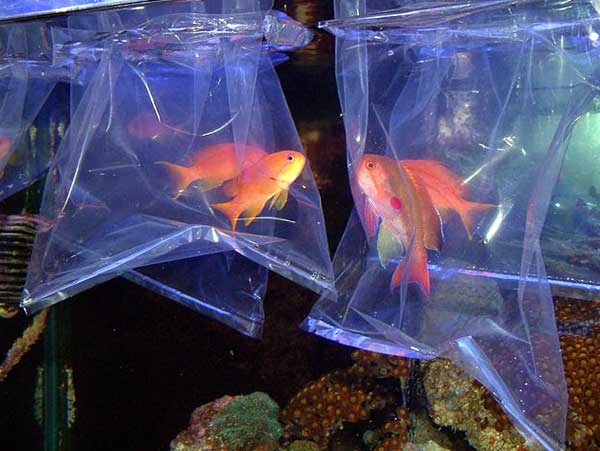
Only 1-2 weeks after such preparation are the fish released, as the ecosystem must be formed.
Pets are released so that they smoothly end up in their new home; first you need to check the water temperature.
The bag with the fish is placed in the pond for about half an hour, then lowered lower so that the water from it and from the aquarium mixes and the fish calmly swims out to its new home.
New settlers are not fed right away. In the first couple of days, they give a moderate amount of food, then increase the volume of portions to normal.
We recommend reading
Rules for breeding aquarium fish
Temperature compliance
Depending on the inhabitants, the water in the aquarium can be cold or warm. Even a small difference of 4-5 degrees can lead to a worsening of their condition. The optimal temperature is +23-24 degrees Celsius (with the exception of angelfish, discus and black fish).
Accordingly, every aquarist should have a thermometer and special heating in order to bring the temperature to the required parameters if something happens.
You can understand that the temperature indicator is not normal by the following signs:
- The temperature is below the optimal level - the activity of the aquarium inhabitants decreases, they become extremely slow.
- The temperature is above the optimal level - the color becomes unnaturally bright, the fish swim to the surface and greedily swallow air.

Algae removal
Over time, algae appear on the walls of the aquarium, which not only impairs the transparency of the view glass, but also negatively affects the overall condition of the aquarium. Before they appear, a small whitish coating appears, which is a colony of bacteria. It is at the site of these colonies that algae begin to grow, which turns a beautiful aquarium into a green box with translucent walls.
Important! Algae do not appear in the aquarium in the presence of biobalance. Their appearance indicates that you are not properly caring for the aquarium.
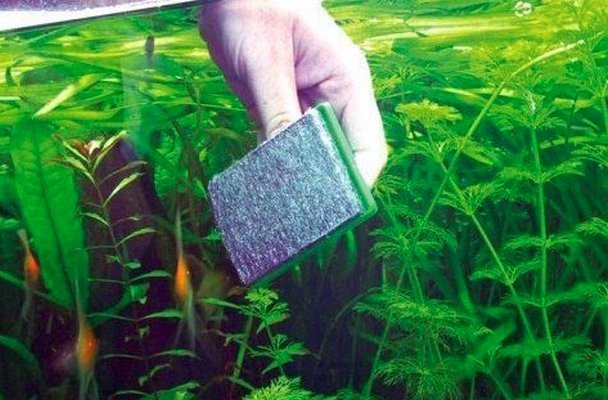
To prevent the development of pathogenic organisms in the aquarium, artificial conditioners such as Methylene Blue and Malachite Green are used.
The main reasons for the appearance of green plaque:
- Using too powerful lighting fixtures or daylight hours exceeding 12 hours.
- Using the wrong lamps. There is such a thing as the emission spectrum that every lamp has. So, if the spectrum is above 5 thousand units (blue light), then the chance of plaque appears increases. The spectrum of an aquarium lamp should be less than 4 thousand units, which also affects aquatic plants.
- Place the aquarium near a window (direct or diffuse sunlight causes an immediate outbreak of green algae).
- The presence of a large amount of organic matter in the water (feces, dead plant remains, dead fish, food residues).
Did you know? Most aquarium fish can live without food for about a month. However, there are record holders who lasted without food for more than 4 months. These were two goldfish from New Zealand whose tank was abandoned during the earthquake.
Video: Tips for controlling algae in your aquarium
Aquarists will be interested in reading about what aquarium algae are, what they do, and how to get rid of blue-green algae, blackbeard, diatoms and planaria.
There are three ways to clean glass:
- mechanical. You can purchase a special scraper or sponge with a magnet at the pet store. These devices are used to remove algae from accessible areas of glass. It is safer to use a sponge on a magnet, since the scraper is equipped with a blade that scratches the glass;
- chemical. Special tablets and liquids are sold that, when added to water, destroy algae. In this case, all lower plants (red and green algae, as well as “blackbeard” and filamentous algae) that grow both on glass and on the ground or decorations are affected;
- biological. Ancistrus catfish and aquarium snails feed not only on green algae, but also on bacterial deposits on glass, and therefore are able to completely clear the aquarium of “thickets” in a few weeks. Of course, the larger the aquarium, the more “cleaners” will be required, but this is the safest way to get rid of green growths.
Important! The chemicals do not harm higher plants or fish.
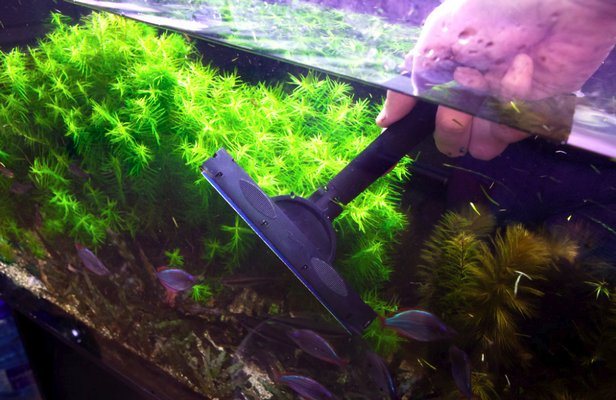
It is important to remember that algae must be dealt with by normalizing the balance in the aquarium, and not just with chemicals. Reduce the amount of food, reduce daylight hours to 8 hours, install the right lamp, do regular water changes, and conditions for algae will become unfavorable.
Changing water
Caring for fish is closely related to caring for the aquarium itself. Many beginners begin to change the water prematurely, as soon as the water becomes slightly cloudy. The fact is that this is a closed ecosystem, so such haste leads to its destruction, therefore, you will have to “start” your aquarium again. Need I say that fish will not react in the best way to such stress?
A universal recommendation is to drain about a third of the water from the tank, adding fresh water to it, i.e. A complete water change cannot be carried out.
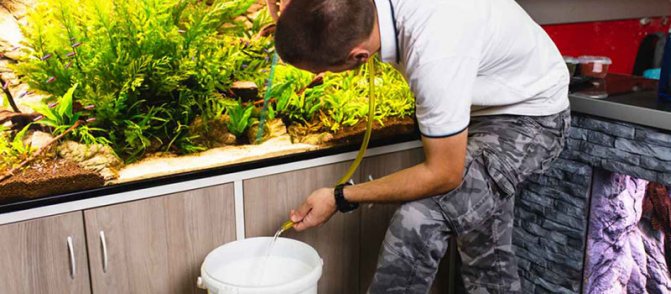
Water preparation
In order to change the water, it must first be prepared. Tap water contains chlorine, metals and differs in temperature and cannot be filled immediately.
To get rid of chlorine, you can go in two ways. Buy a water conditioner that will bind chlorine and metals and simply let it sit for two days.
In addition, the settled water will be comparable to the temperature in your home and will be much more suitable for use.
These simple ways to care for your aquarium will help you keep it clean and beautiful for a long time. Don't be lazy and your aquarium will be a pearl in your home.
Check your oxygen levels
Not a single aquarium fish can survive in conditions of oxygen deficiency. Therefore, you definitely need to buy an aerator, but its power should not be too high. A specialized store will advise you on a suitable model.
If there is algae in the tank, the aerator should be left on overnight. Many plants release carbon dioxide abundantly at night, so if there is not enough oxygen, your aquarium inhabitants will die.
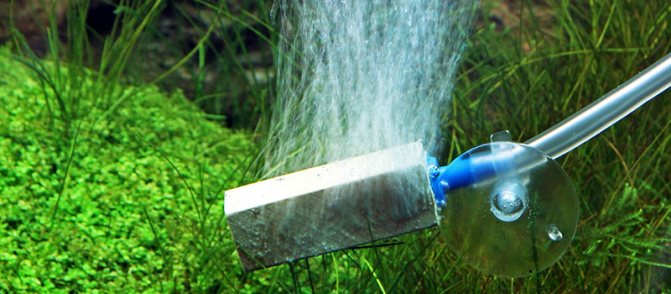
Siphonim soil
After all the operations performed, a lot of turbidity and dirt rises from the bottom, and a hose or siphon is used to remove this obscenity.
What is needed for this procedure?
In a specialized store you can purchase a special device - a cylinder with a hose and a funnel at the end. Select the diameter of the hose according to the size of the debris: it should pass freely along with the liquid. Using a siphon, you can remove detritus and other dead particles from the bottom surface, as well as drain the soil.
So, in addition to the siphon, you also need a bucket. Preferably white, so that if a fish gets into the funnel, you can see it immediately. Remove remaining food, waste and mulch along with a quarter of the water. You need to stick the funnel into the ground several times to remove all the dirt.
Do not stir up the soil too much. This can lead to fish diseases due to problems in the normal functioning of the substrate, which processes organic matter. The reason lies in the fact that the soil surface is covered with special aerobic microorganisms that contribute to the correct progression of the nitrate cycle. It is the top layer of soil that contains oxygen, which plays a decisive role in the life of these microorganisms. In addition, any careless intervention in the structure of the soil entails a lot of difficulties with dangerous chemical compounds.
How do you know when it's time?
Move a couple of pebbles at the bottom and see if air bubbles rise from the bottom. If there are few or none at all, then cleaning the bottom can be postponed. But if there are a lot of bubbles and in addition to them you also observe dark silt and turbidity, then during cleaning it is sometimes necessary to immerse the siphon in the ground.
Typically, excrement and uneaten food do not penetrate into the lower layers of the substrate, of course, if the size of the soil is selected correctly. However, if the waste has penetrated deep enough or the cleaning has not been carried out for too long, a strong process of rotting can begin, causing the water to be filled with dangerous hydrogen sulfide.
In such a situation, aquarium owners say that the substrate has turned sour. It’s easy to verify this: turn over a few pebbles at the bottom, and if you smell the characteristic smell of rotten eggs, you should immediately begin general cleaning. Sometimes this happens because the soil has compacted and begun to rot. This happens due to insufficient water circulation at the bottom. Make sure that algae does not occupy the entire surface of the soil, otherwise it will have to be subjected to heat treatment. Essentially, this is starting from scratch. Therefore, in order not to turn maintaining an aquarium at home into complete torture, carefully monitor the condition of the soil.
Correct lighting
Fish in an aquarium require a sufficient amount of light, which affects their well-being, activity and survival of their offspring. Please note that natural light will not be enough, so you need to take care of purchasing special equipment. There are lamps that not only illuminate, but also disinfect water with ultraviolet radiation .
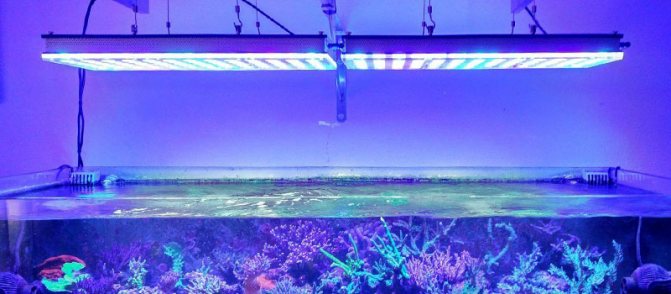
Decorating the aquarium
A talented designer lies dormant in the soul of each of us. Therefore, it is not at all surprising that it is very difficult to find two aquariums that are similar to each other. Pebbles, algae, various plants and other paraphernalia help to dramatically change the original appearance of the purchase, making it a real work of art and a magnificent home for your fish. But in order to do everything correctly, you still need to take into account some rules.
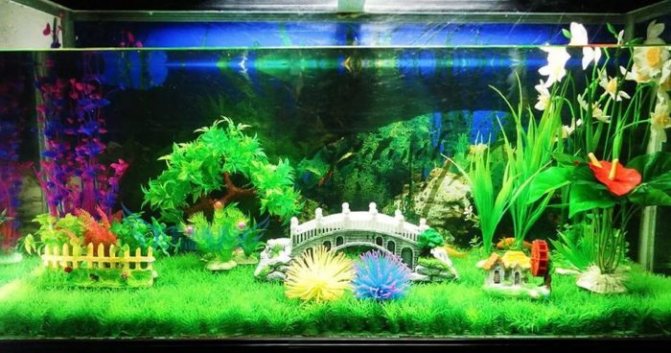
First of all, you need to understand that this is a house, and not a container for various decor. It is necessary to bring the conditions in the aquarium as close as possible to those that existed in the natural habitat of the fish. It is worth emphasizing that this is not a matter of 5 minutes, but after painstaking and thoughtful work, the result will exceed all your expectations.
Important! Particular attention should be paid to the selection of soil.
In addition, you should not forget about such an important detail as disinfection of each new item that you plan to add to the vessel. This approach will avoid unwanted illness or even death of its inhabitants. For example, if these are pebbles, then it is best to boil them a little, after washing and cleaning them.
Choose the right fish for your aquarium
The choice of fish for novice aquarists should be conscious. It should not be based solely on their appearance. For beginners, it is better to choose unpretentious individuals that do not require serious personal care. If you buy too expensive and whimsical fish, then there is a high probability that your first experience will be unsuccessful, because in the first couple it is difficult to avoid mistakes. It would be a good idea to ask the seller about the specifics of caring for a particular type of fish.
There is an important rule - all aquarium fish that you plan to keep in a closed ecosystem must have the same requirements for feeding and water quality. It is advisable to select individuals of approximately the same size and temperament.
When purchasing, it is important to inspect the fish. Any damage, wounds, or problems with scales are a sure sign that you don’t need to buy them. It is better to take non-mature individuals, which are better adapted to changes in habitat.
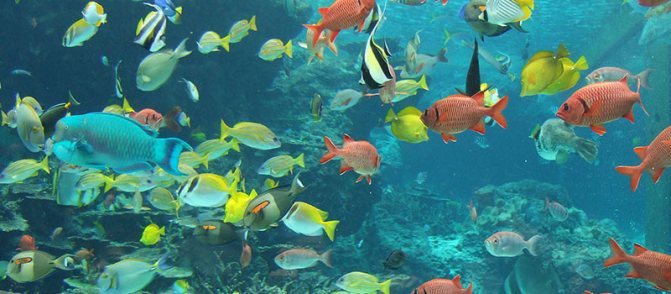
How to properly care for an aquarium every day?
Daily care includes feeding your fish. Count them every day, monitor their behavior and condition. It is important not to forget to check all the devices that are installed in the aquarium. This includes a water filter, lighting elements, and other details.
Fish inspection
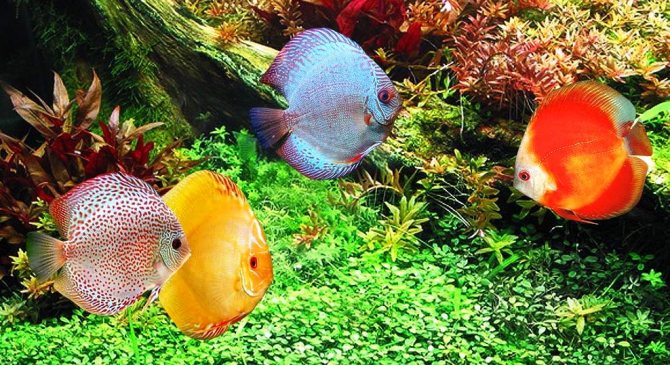
Fish inspection
Useful information: The best time to inspect fish is during feeding time. Then many of them swim out to eat.
If you purchased nocturnal fish, you need to inspect the aquarium with a flashlight . Often fish have a specific place where they like to hide. Watch them and remember this place. If you notice that the fish is not behaving as usual, you should monitor it more carefully. It is better to move it separately from healthy relatives. It happens that it is not possible to save the fish, and it dies. In this case, it is important to immediately remove the corpse from the aquarium.
Equipment check
You need to check the equipment while feeding the fish or when you manipulate the light in the aquarium .
Make sure that the water temperature always remains at the same level. In addition, the water must pass through the filter, properly oxygenated.
Basics of caring for fish in an aquarium
Caring for aquarium inhabitants should be thorough and regular. This includes the correct feeding regimen, cleanliness, and a sufficient level of lighting.
Here are the basic instructions on how to care for fish in an aquarium:
- Don't forget to change the water. First you need to settle it - pour the required amount into the tank and leave it for 2-4 days. Only after this can you add it to the aquarium. In this case, you need to maintain the level of new water: in a 100-liter tank, only 30% of new water is added (for a 200-liter aquarium this figure is less - only 20%). Settled water must be brought to the required parameters using chemical reagents.
- Regularly clean the bottom of food residues using a siphon.
- Do not turn off the heating unless absolutely necessary.
- Monitor their appearance every day. Any deviation from the norm (wounds, dull color, decreased activity) is a reason to isolate the fish (it is placed in a separate tank).
- You definitely need a scraper to clean aquarium glass from dirt and algae. The driftwood is cleaned with a regular brush (once every 2 weeks).
engaged in the production and comprehensive maintenance of aquariums. Installation of filtration systems, scheduled water changes, cleaning, and treatment of fish are just a small part of the activities that this service includes. To keep your pets always healthy and pleasing to your eyes, follow the tips we talked about today. For our part, we will provide you with all possible assistance, taking care of all the care - all you have to do is feed your fish.
Cleaning the soil in the aquarium
A good filter will partially remove waste from the aquarium, but most of it will still settle in the ground. Fish waste and food residues settle in the soil and, when rotting, upset the balance, stimulating the growth of algae.
In order to prevent the soil from stagnating and rotting, it is necessary to clean it using a special device - a soil siphon. Siphons may vary in size, shape and functionality, but the principle is the same.
The soil siphon uses the principle of water flow. The pressure of water washes out the light parts from the soil, and the heavy ones settle back. The result is very useful - all the dirt goes away with the flow of water, the soil is clean, the water is cleaner, and the growth of algae is reduced.
Since using a soil siphon requires a large amount of water, it is wise to carry out cleaning along with partial replacement. That is, instead of simply draining some of the water, you clean the soil and thereby achieve two goals at once.
For herbalists, cleaning the soil can only be done superficially, since it cannot be reached everywhere. But in them, much more harmful substances are decomposed by the plants themselves, and silted soil promotes good plant growth.
Selecting and checking accessories
When setting up an aquarium, you need to consider the choice of necessary equipment. It is its uninterrupted operation that ensures the preservation of comfortable living conditions for fish and plants.
Filtration system
Water filtration is provided by internal and external filters. If you need to save space inside a small container, choose an external filter. This placement has undeniable advantages if the aquarium contains small fish that tend to seek shelter in unusual places, including in the filter. A powerful device can suck in small fish and eggs.
The internal filter is easy to clean - it takes a few minutes to clean the filter element (sponge). In addition, such a system costs less than an external one. Placement inside the aquarium prevents leaks and does not require additional space for placement. But it also has disadvantages, the main one of which is a weak cleaning system. The internal filter is not equipped with fillers for chemical cleaning.
The external filter may have several sections that are filled with activated carbon, peat, zeolite, and special fillers with antinitrate and antiphosphate properties. In addition, fillers for biological treatment can be placed in it. The performance of external filters is higher, and the degree of water purification is better. These advantages are especially important when filling an aquarium with fish species that are sensitive to the composition of water, as well as in maintaining biocenosis in large-volume containers.

Filters need to be periodically cleaned and fillers replaced. Small internal filters need to be cleaned more often. Mechanical particles clog the pores of the sponge, reducing system performance. If the aquarium contains fish that love to dig in the soil, then you need to clean the filter often. The filter is disassembled, the fillers and sponge are washed under running water without using cleaning agents or detergents.
The internal surfaces are wiped with a cloth to remove accumulated mucus and dirt. Ceramic rings are washed in aquarium water to preserve beneficial bacteria. Internal filters are cleaned every 2-4 weeks, and external filters every 3 months.
Aeration system
Aeration equipment is necessary to maintain dissolved oxygen levels and agitate the water. Some types of fish are very sensitive to oxygen levels, so an aeration system in such an aquarium is mandatory.
In home aquariums, membrane and piston compressors are used. Vibration or diaphragm pumps are quite powerful, have low energy consumption, are cheap, but produce a lot of noise.
Piston compressors, which have a large number of modifications, can create high pressure. They are best used in aerating large aquariums. Compressors do not require frequent maintenance.
Water heaters
To provide comfortable conditions for tropical fish and plants, water heaters are used. Spawning, the condition of the fry, and the activity of the fish themselves often depend on its temperature. When choosing a thermostat, pay attention to:
- ensuring uniform heating of the entire volume of water. To do this, the length of the heating element must correspond to the depth of the reservoir;
- safety and tightness, compatibility with a thermostat;
- correctness of thermostat readings and maintaining the set mode.
The heater must be periodically inspected in order to eliminate leaks in time. Using a conventional thermometer, the heat production of the heater is checked. The permissible discrepancy in readings is ≤ 2°C.
Lighting
The lighting of the aquarium is also of great importance. Some plants prefer intense light, while some fish prefer dim light. Therefore, when choosing lamps, you need to correctly calculate the power. When exposed to intense light, they can heat the water, which promotes the proliferation of pathogenic microorganisms. To avoid this, the lamps are shielded with reflectors and placed at a considerable distance from the surface.
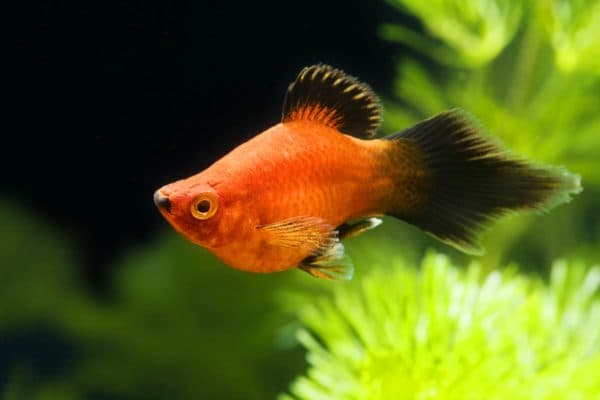
It is imperative to include maintenance of devices and systems in your aquarium maintenance schedule. Starting a new aquarium requires compliance with certain rules. After all systems have been installed and tested, the pond must “stand” for at least a week. Only then can you put fish in it. To speed up the formation of a suitable biocenosis, capsules with microorganisms are used - Biocorin, Biostarter.
Soil selection
Soil plays an important role in creating a winning background for fish and a substrate for plants. For fish with light, bright colors, you should choose dark soil. Against its background, the fish will look more impressive. For dark fish it is better to choose a light background.
Some types of fish like to burrow in the ground. To prevent turbidity from rising, the bottom is covered with small river pebbles. It is easy to clean (siphon), the water does not spoil, does not emit harmful substances and does not injure the fish. If the inhabitants do not require living plants, then the soil can be decorative. But it must also meet safety requirements.
If the aquarium is decorated with plants, it is necessary to provide a nutrient substrate for their growth. For this purpose, special substrates are used, which are placed on a glass bottom and covered with pebbles, pebbles, and sand. However, they can affect water characteristics, cause bacterial outbreaks and uncontrolled plant growth. It is better for experienced aquarists to work with such soils. Beginners can plant unpretentious plants that grow well on sand or gravel without a substrate.
The soil is periodically cleaned of detritus using a siphon. But the microbiocenosis of the reservoir depends on the composition and condition of the soil. Bacteria live on it, utilizing most of the ammonia, nitrates and nitrites. Disturbing the surface and mixing the soil can lead to their death. The thickness of the layer depends on the soil fraction and the type of plant root system.
Aquarium accessories
There are mandatory items that should be purchased for an aquarium. In particular, these are lighting, filter, aerator, water heater.
- The lighting is selected depending on the guests of the pond and the flora.
- Filters and aerators are selected depending on the volume.
- a water heater with an automatic operating mode for proper, uninterrupted temperature maintenance.
All other accessories: soil, vegetation, decorative details are chosen, depending on its inhabitants and according to your taste. But we can definitely say that a base (soil) of fine rounded gravel without sharp corners will be universal for everyone. The base of it should be 5–7 cm: this is a favorable thickness for rooting by algae.
Artificial paraphernalia is at your discretion. With its help, you can decorate your aquarium and create a unique underwater world.
Prospects for the aquarium
Caring for a home aquarium is not that difficult, and we hope our instructions will help you solve most of your questions and problems. Do not forget that fish are just like pets that require responsibility and serious attitude. And given that the balance in the environment in which they live can easily be upset, we urge you to be careful when observing the basic aspects of maintaining an aquarium.
Don't be afraid to become an aquarist, everyone was a beginner at some point. Read, learn more, and then you can provide your aquarium pets with excellent conditions and a long life.
Water quality
Pay special attention to water quality. Water is very important for fish. In addition to changing and cleaning it, also keep an eye on its composition. All fish, without exception, are very sensitive to chemicals. Therefore, an unbalanced water chemistry can lead to negative consequences. Keep it under control. There are special techniques for this. Reagent tests. With their help, it is easy to determine whether water meets the standards.
Fill a dry container (glass, test tube) with water from the aquarium and immerse the indicator in it. After five minutes, the result is ready.
In case of deviations, measures should be taken to normalize it. It is recommended to carry out such a test when starting up the aquarium for the first time and periodically in the future.
Aquarium for beginners
Let us admit honestly that fish are creatures that, at home, bring us purely aesthetic pleasure when contemplating them. Therefore, an important task for us is to organize their place of stay for the benefit of the fish and harmony with the interior of the room.
As for the creatures of the aquatic world themselves, there are requirements for space (a body of water) for their comfortable life. The capacity of the fish pool should be one liter of water per centimeter of mature fish. Therefore, think in advance about the size of the aquarium you need in order to accommodate the desired inhabitants.
Having dealt with the area, let's move on to the shape. Aquariums of different capacities can have all possible forms of its implementation. The shape, as a rule, is chosen depending on the type and design of the room, that is, according to the interior.
Aquariums come in the following forms:
- round. Usually small in size, easy to place on a desk or dressing table;
- square, rectangular, panoramic. Often installed on special stands or cabinets. Ideal for comprehensive contemplation;
- The prism aquarium is generally large in size with a special bottom. Installed directly on the floor;
- triangular, hidden. Usually embedded aquariums that are visible from one side.
Requirements for installing an aquarium
Its location should allow access to unhindered removal of the lid, cleaning the reservoir, feeding fish, and the like. Place in such a way that there is no direct sunlight. Maintain the correct ratio of aquarium inhabitants and its capacity.
Standard aquarium
The aquarium itself can be equipped with a backlit lid, which performs practical functions:
- will not allow fish to jump out of it;
- prevents water evaporation;
- illuminates the aquarium.
A practical solution would also be to purchase an aquarium cabinet. Together they create a beautiful look. Serves as a stand and storage place for his care items, food, etc.
Maintenance of aeration equipment
- Vibrator air pumps, and sometimes check valves, contain air filters that require cleaning or replacement from time to time.
- Both of these devices may also have rubber membranes that lose their elasticity over time and need to be replaced. For air pumps, new diaphragms can be purchased, while check valves usually have to be completely replaced.
- Sprayers often become clogged, sometimes due to bacteria, and in hard water due to calcium carbonate deposits. In this case, they must be cleaned or replaced.
- Piston air pumps require regular lubrication and periodic maintenance at repair shops. For both of these matters, follow the manufacturer's instructions.
- Duct hoses eventually become hard, inflexible, and sometimes brittle—especially the parts that are submerged in water. If this problem occurs, replace or trim them.
